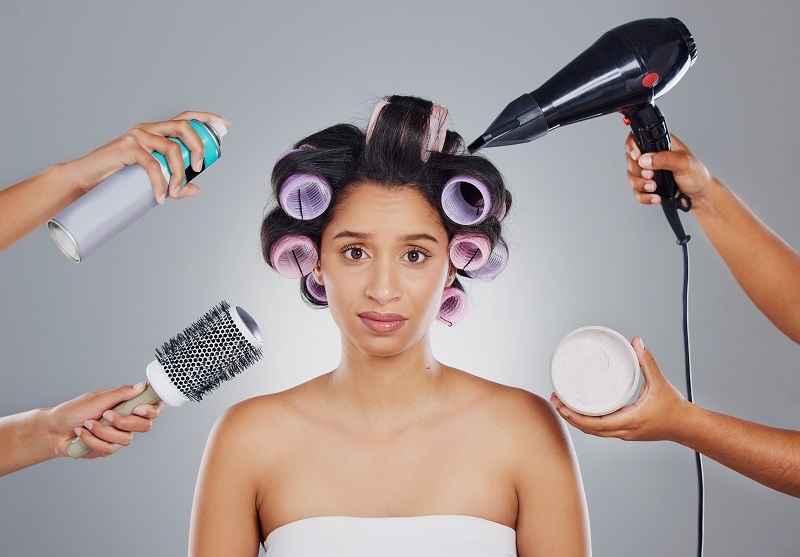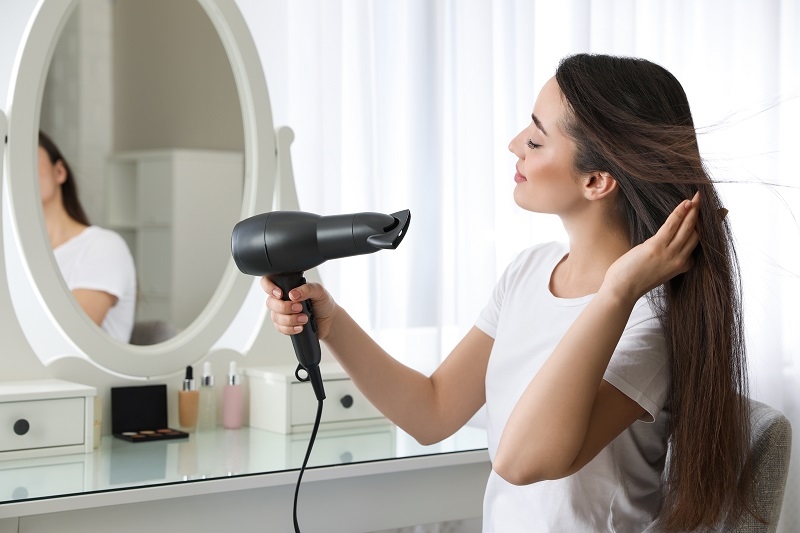
Heat styling tools, like blow dryers, flat irons, and curling irons, can transform hair from lifeless to fabulous in minutes. These tools can help you style your hair quickly and easily, whether you want sleek and straight hair or bouncy curls; however, there is a downside. Heat styling can damage hair, leading to dryness, breakage, and split ends.
Fortunately, you will not have to give up styling your hair completely. Learning and practicing the proper heat styling techniques, you can have your desired style while still keeping your hair healthy. This article will help you understand everything from heat settings to protective products to safe heat styling tips.
Before discussing heat styling safely, it is important to understand what heat does to your hair. Inferior heat styling tools will use excessive heat, removing moisture and damaging the protein structure of the hair shaft. This will cause your hair to look dull, frizzy, break and in extreme cases, cause permanent damage. If you have ever noticed your hair had split ends or a coarse texture after you used your favorite styling tools, heat is probably the cause.
Don't worry, if you change your approach to how and when you style your hair, you can avoid these damaging issues and still use your tools.
Working on clean, dry hair is among the most fundamental yet significant safe heat styling tips. A major no is using a flat iron or curling iron on wet or damp strands; it literally boils the water within the hair shaft, causing damage.
If you are rushed and need to blow-dry, make sure the hair is first towel-dried at least 60%. This minimizes the time and heat exposure your hair has to endure.
Let your hair air-dry for a bit whenever possible before using heated tools. Less exposure lowers one's damage potential.
Applying the best heat protectant spray before using any styling tool is among the greatest approaches to protect your hair. This product coats your strands, therefore trapping moisture and minimizing the effects of direct heat.
Seek heat protectants made with silicones, keratin, or argan oil. These provide brightness and smoothness in addition to protecting value. Check the label to be sure it fits your practice; some sprays are made for use with blow dryers, while others are preferable for flat irons or curling wands.
The key is reapplying. If you have created one area and are now heading to another, spray a little more product to keep it safe.
One of the easiest, most efficient behaviors you may integrate into your hair care regimen is using the finest heat protectant spray.
Not every heat styling gadget is made the same. Some are made for certain hair textures or lengths. Selecting the wrong one can make styling more difficult and more harmful.
Though it would be appealing to run your straightener at the hottest temperature for quicker results, doing so is among the quickest ways to damage your hair. Correct flat iron temperature settings, depending on your hair type, can drastically change things.
General directions follow:
These flat iron temperature levels enable you to get even outcomes without frying your hair.
Many individuals abuse curling irons unknowingly. Learning curling iron safety helps you to safeguard your hair as well; it goes above and beyond preventing burns to your fingers.
This is how to remain safe while curling:
Using your tool with patience and care helps you to prevent fried ends and burned fingertips.

After a shower, it's simple to get in the habit of hot-air blasting your hair. Still, there are wiser approaches to doing it. Here's what to bear in mind if you want to achieve blow drying without damage:
Try not to blow-dry your hair daily either. One of the greatest safe heat style advice you can adhere to is to let your hair rest between styling appointments.
Styling daily is still difficult on your hair even if you're doing everything correctly. Avoid heat some days to enable your strands to heal. This will support better development, preserve natural oils, and lower split ends.
To keep your style overnight, try sleeping with your hair in braids or buns. The less often you must touch up with heat, the better your hair will be.
Safe styling is more about how frequently you do it than just your methods.
If you want a break from hot tools, there are many heatless substitutes for curling and straightening. Though these strategies might take more time, with some patience, they may be just as effective.
Among excellent no-heat styling techniques are:
Allowing any one or two days for heatless styling can go a long way in nourishing your hair and enjoying more looks.
Investing in good equipment is rather important if you use heat instruments often. Low-cost versions tend to lack safety features, tend to overheat, or tend to break down quickly. Somewhere, you shall look for auto shut-off features, digital temperature controls, and ceramic or tourmaline plates.
Better tools sometimes last longer, style quicker, and over time create less heat damage. Though it could seem like a major investment upfront, your hair will ultimately thank you.
Damage is a sure thing in a damaged process. Often, cutting hair might help stop split ends from splitting in the shaft. A conditioner or moisturizing mask is useful for restoring lost elasticity and moisture.
Deep-conditioning treatments, while limited, should be done weekly, especially once typing, as that will further harden your hair against damage, leaving it soft and easy to use.
Good aftercare helps you style your hair with heat safely.
Using a hair styling tool does not mean the health of your hair or giving up. These good heat-styling tips will help you achieve fabulous styles without the dryness and damage usually associated with regular heat use.
Start with knowing the correct flat/straight iron heat settings, the best heat protectant sprays, curling iron safety, and damage-free blow-drying. When you do not need heat, give your hair a daily reprieve by trying heatless alternatives.
This content was created by AI